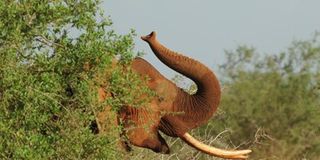Jumbo hit by poisoned arrows rescued in Tsavo

Elephants forage at the Tsavo-East National park on March 19, 2012 during the second phase of a collaring exercise. A bull elephant was rescued from poachers on September 24, 2014 in the park and treated for poisoning and wounds. AFP FILE PHOTO |
What you need to know:
- The veterinarian in charge of Tsavo, Dr Jeremiah Poghon, said an air surveillance team spotted the jumbo and noticed it was limping. This prompted the rescue.
- Poaching has become a real menace as it has been threatening wildlife and by extension, tourism, as poachers become more sophisticated.
- Kenya had lost 116 elephants and 26 rhinos to poachers by the end of last month. This was a reduction from 2012 when the country lost 384 elephants and 30 rhinos, according to the agency.
A bull elephant was Wednesday rescued from poachers in Tsavo East National Park and treated for poisoning and wounds.
A rapid air response by Kenya Wildlife Service and David Shedrick Wildlife Trust officers helped save the wounded animal from poachers who were pursuing it after attacking it on Monday.
The veterinarian in charge of Tsavo, Dr Jeremiah Poghon, said an air surveillance team spotted the jumbo and noticed it was limping. This prompted the rescue.
Officers from Nairobi managed to reach the elephant and then went after the poachers.
“We reached the scene quickly thanks to the helicopter. We darted the elephant with a high dose of anaesthetic to enable us attend to it and we know it will be fine,” Dr Poghon said.
He said they cut away a large amount of dead tissue from the wounds and cleaned it by administering a long acting antibiotic.
“The huge elephant had life threatening wounds. We administered a reversal anaesthetic drug to help it back to its feet,” Dr Poghon said.
“Use of poison arrows which leads to a slow and agonising death for an elephant if untreated has become common,” he said in a statement on Shedrick trust website.
“The jumbo could have died and its ivory taken away were it not for the quick response.”
No arrests were made as the poachers escaped.
Shedrick Wildlife Trust director Rob Brandford said the war on poaching will be a little easier with support from others.
“Wildlife conservation and protection, including rapid wildlife veterinary support, must be complemented if we are going to make progress,” Mr Brandford said.
REAL MENACE
“A report published last month reveals that more than 100,000 elephants have been killed across Africa in the last three years, which translates to one elephant killed every 15 minutes,” Mr Brandford added.
Poaching has become a real menace as it has been threatening wildlife and by extension, tourism, as poachers become more sophisticated.
Kenya Wildlife Service Director-General William Kiprono said Kenya has made strides in containing the problem.
“After sustained efforts to deal with poaching gangs, the worst is now behind us,” he said.
“Statistics have shown a decline in poaching since 2012,” Mr Kiprono said.
Kenya had lost 116 elephants and 26 rhinos to poachers by the end of last month. This was a reduction from 2012 when the country lost 384 elephants and 30 rhinos, according to the agency.
In 2011, poachers killed some 289 elephants and 29 rhinos, the agency says.





